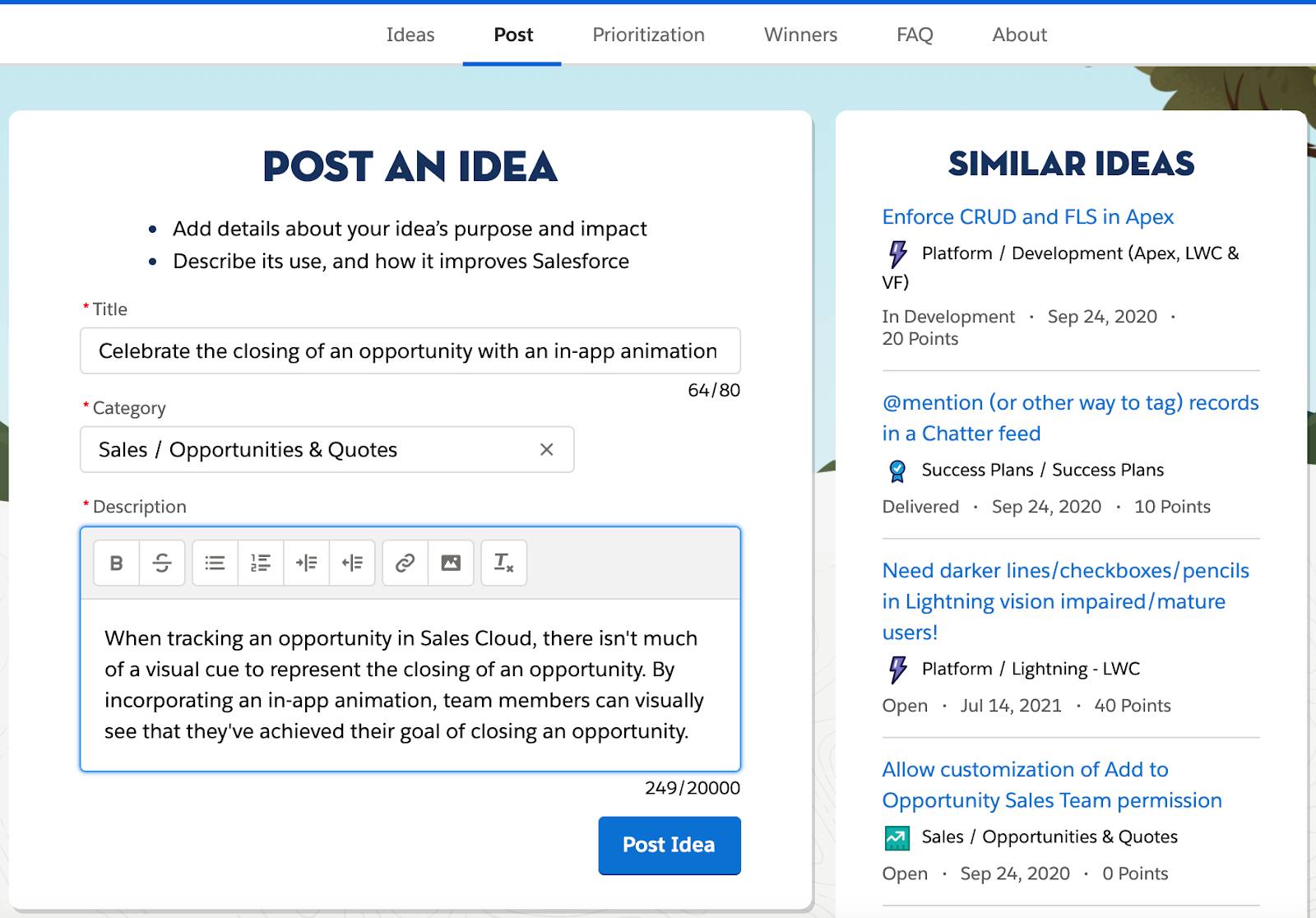Post and Upvote Ideas
Learning Objectives
After completing this unit, you’ll be able to:
- Write a well-formed idea.
- Support an existing idea by upvoting it.
- Improve an existing idea by commenting on it.
Browse and Post Ideas on the IdeaExchange
Jose is excited to see if anyone else has the same idea about finding a way to immediately celebrate closing a successful Opportunity in Salesforce. Taking Linda’s advice, he visits the IdeaExchange by navigating to ideas.salesforce.com. There, he uses the Idea Search to look up keywords such as celebration and recognition but doesn’t come across an idea quite like his.
Post a Well-Crafted Idea
You’ve thought of a great idea and now it’s time to share it with others. To excite the community and attract the attention of Salesforce product managers, it’s important to post a well-crafted idea. To help you even further, similar ideas will appear as you fill out an Idea Submission so you can see what other ideas have been posted to the IdeaExchange.
On the IdeaExchange, an idea consists of three parts.
- Title
- Category
- Description
Jose wants maximum exposure and support for his idea. To increase the chances it will rise to the top and get implemented as a new feature, he follows these best practices.
Title
To grab readers’ attention and differentiate your idea from similar ones, your title should grab the crowd’s attention, while still being descriptive and pithy.
Although Jose wants to see a high-five animation, he decides that his title should be broad enough to encompass other forms of recognition. He chooses: “Celebrate the closing of an Opportunity with an in-app animation.”
Category
A category associates an idea with a specific Salesforce product. This helps community members and Salesforce product managers find your idea by searching. You can search for and select the category that’s right for your idea. However, if you’re not confident about which category to choose, make your best guess.
Jose’s idea is for sales reps and it occurs as part of the sales cycle, so he selects the Opportunities category under Sales Cloud.
Description
Well-formed idea descriptions contain several elements.
- Details about your idea’s purpose and impact
- Focus on an objective
- Description of its use, and how it improves Salesforce
Although it’s tempting to immediately describe the functionality of a new feature or solution, it’s important to step back and describe the objective or problem statement. This often builds empathy and sparks more engagement and conversation from others. When writing your description, refer to this guidance.
Element |
Guidance |
|---|---|
Situation |
Describe where in the product your idea fits and who would benefit from it. For existing features, this could include pain points or the root cause of an issue. |
Purpose & Impact |
Explain the objective of your idea. Rather than propose a solution, focus on the impact of how your idea is improving the feature. |
Use Case & Solution |
With the situation and objective in mind, describe at least one use case and your proposed functionality. |
Now that Jose has grabbed our attention with a compelling headline, it’s time to clearly and concisely explain the idea and why it may be useful to others. He crafts this description.
“When tracking an Opportunity in Sales Cloud, there isn’t much of a visual cue to represent the significant event of closing a won Opportunity. A more pronounced visual cue upon changing an Opportunity to Closed - Won would provide instant recognition to the rep, help drive adoption of Sales Cloud, and provide confirmation that the Opportunity is in the right closed state.
For example, when a sales rep updates an Opportunity to Closed - Won, an animated graphic showing hands clapping could pop up on the screen for 5 seconds.”
The first sentence orients the reader to where in the product this feature could be implemented. The second articulates the objective of the idea and how it will improve the feature. Jose finishes his idea with a use case that includes his proposed solution.

When crafting an idea description, consider including an image to illustrate the idea or highlight an area for improvement. Just remember to exclude screenshots and images that contain sensitive information.
Support an Idea by Upvoting
Using the IdeaExchange, you can explore ideas by category or browse trending or popular ideas across categories from the homepage.
To show support for an idea, when logged in, click Upvote, which adds a vote and 10 points to the idea. Alternatively, if you’re opposed to an idea, click Downvote to remove 10 points. The more points an idea receives, the more likely a product manager will review the idea and consider it for development.

Enrich an Idea with a Comment
As you’ve learned, one of the benefits of crowdsourcing is the popcorn effect where one idea sparks another. By commenting on an idea, you can:
- Offer additional suggestions or a new perspective.
- Seek clarification if the idea is vague.
- Share your own use cases.
- Respond to follow-up questions from Salesforce product managers.
Use the idea description guidelines to construct comments that are useful to other community members and to Salesforce product managers. Also, be sure to abide by the Trailblazer Community participation guidelines—which remind you to keep your comments constructive and cordial.
Don’t Just Post, Promote!
After you create an idea, or when you come across one that you really like, don’t keep it to yourself. Use the Trailblazer Community and your professional social networks, such as Twitter and LinkedIn, to promote the idea.
Jose shared his new idea with Linda and others at Cloud Kicks. Linda upvoted the idea and also told her local Salesforce Admin Community Group about it.
Next, fast forward in time to see how Jose’s idea has grown in popularity and has been enriched by comments from other community members.
Resources
- Trailblazer Community: Salesforce IdeaExchange
- Trailblazer Community: IdeaExchange Frequently Asked Questions
